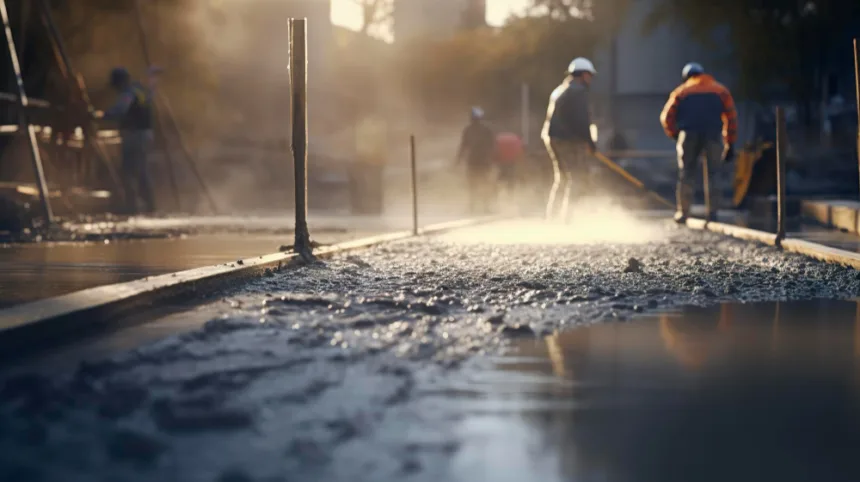Concrete serves as the cornerstone of many structures ranging in height from simple sidewalks to enormous skyscrapers. While not all forms of concrete are equal, how it’s mixed has a substantial effect on its characteristics, performance and suitability for specific tasks. Building is generally divided between wet-mix and dry-mix techniques for mixing the substance; each technique comes with both benefits and drawbacks, which builders need to recognize in order to select an effective course of action for their projects.
Dry Mix Concrete: What Is It?
Dry Mix Concrete (or “Dry Batch Concrete,” more accurately) involves mixing certain amounts of materials such as cement, sand, aggregates and additives – such as wet mix concrete – on site; while with dry-mix concrete it’s made in advance at a factory and delivered ready-mixed; unlike wet concrete it does not require water during initial mixing steps for proper performance.
Advantages of Dry Mix Concrete:
- Consistency and Quality Control: Because dry mix concrete is produced at a carefully monitored batching facility, its consistency and homogeneity is unparalleled, guaranteeing accurate ingredient quantities to deliver reliable performance in terms of both quality and performance.
- Material Waste Reduction: Dry mix concrete waste reduction can be greater as its material waste requirement is much reduced compared to that associated with wet mix concrete, since its pre-mixed state allows it to arrive directly at its destination site ready-for use.
- Enhanced Workability: Additives may also help increase the workability of dry mix concrete by improving its workability and flow properties, making it simpler to handle and install in construction applications.
- Faster Construction: Dry mix concrete reduces both construction time and labor expenses by eliminating on-site mixing needs, speeding up construction while not compromising quality of finished projects. Builders may complete more projects more rapidly without compromising their integrity.
- Dry Mix Concrete Is Perfect for Remote Areas: When building projects in isolated or hard-to-access regions where mixing facilities may not exist, dry mix concrete offers the ideal solution.
The Drawbacks of Using Dry-Mix Concrete
- Restricted Setting Time: Dry mix concrete presents several disadvantages that must be considered before its use can begin, including the reduced setting time when water is added – this requires careful planning to ensure no delays arise during placement and finishing processes.
- Less Adaptability: While wet mix concrete allows for adjustments on-site to its mix proportions, dry mix concrete cannot be altered once mixed.
- Discrimination Risk: Improper handling or transport can result in dry mix concrete segregating into heavier particles that settle to the bottom, creating uneven material distribution and diminishing quality.
Danger of Discrimination:
At a central batching plant, cement, aggregates, water and additives are mixed to produce wet mix concrete or ready-mix. Transit mixers then transport this mix directly to building sites where it’s immediately poured into molds for pouring. Water may be added just prior to placement for maximum control over its consistency and curing times.
Wet Mix Concrete: What Is It?
One advantage of wet mix concrete is its flexible mixing ratio adjustments on-site. This enables builders to fine-tune the mixture to meet project specifications and environmental considerations more precisely.
- Extended Workability: The water add-in extends the workability of wet mix concrete on building sites, giving workers more time for placement, finishing, and curing of finished projects.
- Bond Improvement: As wet mix concrete can flow and conform to complex curves and contours, it enhances bonding between reinforcing elements like steel bars and mesh and its surroundings.
- Minimal Risk Of Segregation: Since wet mix concrete is typically mixed and transported as one continuous mass, its chances of segregating during transportation are minimal; as a result, its final appearance should always remain uniform and uniform.
Selecting an Appropriate Resolution for Your Task:
There are various criteria that need to be considered when choosing between dry mix or wet mix concrete for building projects:
- Prerequisites of Your Project: Take all factors, such as strength, durability, workability and setting time, into account when selecting concrete type for use on the job site.
- Site Specifics: Whether or not dry mix or wet mix concrete should be utilized on any particular building site may depend upon several variables such as its location, accessibility and environmental condition.
- Cost Considerations: In order to ascertain which form of concrete would be more economical for the project, compare its associated labor, material and transportation expenses as well as any waste generated during production.
- Timetable of Construction: Review your project timelines and dates in order to establish which is most suited for meeting project milestones: wet mix concrete’s flexibility and workability or dry mix’s speed and efficiency.
- Quality Assurance: Concrete solutions must meet regulatory, specifications and performance criteria specific to their intended applications; quality control and assurance procedures should take top priority when choosing one.
Conclusion
Overall, many factors such as project needs, site conditions, financial considerations, timeline and quality assurance play into deciding between dry mix and wet mix concrete for building projects. Builders may use this knowledge to select an option that provides maximum benefits while simultaneously mitigating possible drawbacks of each strategy to secure optimal outcomes in their endeavours.


Leave a Reply